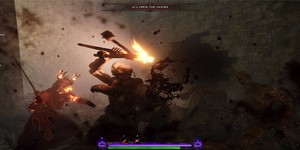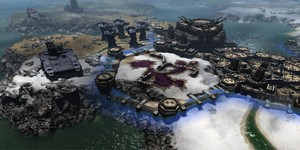Warhammer: The End Times: Vermintide Review
October 28, 2015 | 13:45
Companies: #fatshark #games-workshop

The other notable change is that character class affects the player's loadout. The Witch Hunter, for example, starts off with a rapier and dual flintlock pistols, while the Pyromancer begins the game with a fire staff and the fanciest longsword I have ever seen. What’s more, new and upgraded weapons can be unlocked for each class via a weird dice-rolling minigame played at the end of each mission, while weaker items can be combined in the “Forge” to form more powerful items. So there’s an element of progression and reward in Vermintide’s play beyond merely surviving the Skaven assault.
All told, Vermintide is a substantial game, including 13 large campaign missions and numerous smaller side-quests. But it’s in the breadth of those campaign missions where Vermintide makes its first significant misstep. Each rivals the length of a single Left4Dead campaign. But unlike a Left4Dead campaign, the mission is completely seamless. This is great for keeping the flow of the action going, but it also means there are no save points. Several times I’ve reached a mission finale, only to be eliminated during the ensuing onslaught and forced right back to the start of the mission. Such lengthy reruns quickly become a drudge, even with the random enemy spawning of Vermintide's AI director.
Easily Vermintide’s most significant issue, however, is that the combat simply doesn't feel particularly great. What made Left4Dead such a frantic thrill-ride was is that its combat was sharper than a porcupine's stand-up routine. Its collision detection was atomically precise. Its weapons were sleekly designed, yet powerful and deadly. Its procedural zombie animations the best in existence at that time. Even Left4Dead 2’s melee combat, which everyone fretted about prior to release, proved itself a surprisingly excellent addition, all thanks to the attention Turtle Rock paid to it.
By comparison, Vermintide simply doesn’t have that razor-like edge to its combat. The characters feel a little too sluggish and floaty, and there’s a slight but noticeable delay between striking and enemy and witnessing the messy result. It often feels like you’re wafting your weapons in front of your opponent, rather than actually hitting them. Interestingly, this problem was also evident in Fatshark’s previous games, War of the Roses and War of the Vikings, and it’s disappointing that this mechanical sponginess has carried over into Vermintide.
Admittedly, the extent of the problem varies depending on which weapon you are wielding. The soldier’s Warhammer is probably the weakest example, having all the sense of impact of slapping someone with a giant foam hand while underwater. But when you sweep the Witch Hunter's Zweihander through a crowd of Skaven, it feels tremendously lethal, like an Ebola casserole. My favourite weapon in the game is probably the pyromancer’s staff, which causes a satisfying “whoomph” whenever a fireball ignites a Skaven's fur.
Despite these problems, Vermintide can be pretty enjoyable. In those moments where you’re surrounded by Skaven, one party member down, another being dragged into some dark corner by a Skaven Packmaster, and yet you dig deep, slice through the enemy ranks and emerge bloodied but unbeaten, the feeling of accomplishment is undeniably satisfying. The game also shares Left4Dead's unpredictability. Some missions you’ll blast through with the professionalism of a fantasy SWAT team, each player fulfilling their role expertly. Other times, the game will pick your team apart like rats gnawing at a corpse dumped in a sewer.
Unfortunately, I can't help but feel that Vermintide's qualities are a consequence of how closely it sticks to the Left4Dead formula, rather than anything Fatshark have added to it. Luckily for Vermintide, there are very few games that have the same intensity and engender the same teamwork as Turtle Rock’s classic did. Flawed though Fatshark's attempt may be, it does just about manage to scratch that cooperative itch, and because of that I'd give it a tentative recommendation.
All told, Vermintide is a substantial game, including 13 large campaign missions and numerous smaller side-quests. But it’s in the breadth of those campaign missions where Vermintide makes its first significant misstep. Each rivals the length of a single Left4Dead campaign. But unlike a Left4Dead campaign, the mission is completely seamless. This is great for keeping the flow of the action going, but it also means there are no save points. Several times I’ve reached a mission finale, only to be eliminated during the ensuing onslaught and forced right back to the start of the mission. Such lengthy reruns quickly become a drudge, even with the random enemy spawning of Vermintide's AI director.
Easily Vermintide’s most significant issue, however, is that the combat simply doesn't feel particularly great. What made Left4Dead such a frantic thrill-ride was is that its combat was sharper than a porcupine's stand-up routine. Its collision detection was atomically precise. Its weapons were sleekly designed, yet powerful and deadly. Its procedural zombie animations the best in existence at that time. Even Left4Dead 2’s melee combat, which everyone fretted about prior to release, proved itself a surprisingly excellent addition, all thanks to the attention Turtle Rock paid to it.
By comparison, Vermintide simply doesn’t have that razor-like edge to its combat. The characters feel a little too sluggish and floaty, and there’s a slight but noticeable delay between striking and enemy and witnessing the messy result. It often feels like you’re wafting your weapons in front of your opponent, rather than actually hitting them. Interestingly, this problem was also evident in Fatshark’s previous games, War of the Roses and War of the Vikings, and it’s disappointing that this mechanical sponginess has carried over into Vermintide.
Admittedly, the extent of the problem varies depending on which weapon you are wielding. The soldier’s Warhammer is probably the weakest example, having all the sense of impact of slapping someone with a giant foam hand while underwater. But when you sweep the Witch Hunter's Zweihander through a crowd of Skaven, it feels tremendously lethal, like an Ebola casserole. My favourite weapon in the game is probably the pyromancer’s staff, which causes a satisfying “whoomph” whenever a fireball ignites a Skaven's fur.
Despite these problems, Vermintide can be pretty enjoyable. In those moments where you’re surrounded by Skaven, one party member down, another being dragged into some dark corner by a Skaven Packmaster, and yet you dig deep, slice through the enemy ranks and emerge bloodied but unbeaten, the feeling of accomplishment is undeniably satisfying. The game also shares Left4Dead's unpredictability. Some missions you’ll blast through with the professionalism of a fantasy SWAT team, each player fulfilling their role expertly. Other times, the game will pick your team apart like rats gnawing at a corpse dumped in a sewer.
Unfortunately, I can't help but feel that Vermintide's qualities are a consequence of how closely it sticks to the Left4Dead formula, rather than anything Fatshark have added to it. Luckily for Vermintide, there are very few games that have the same intensity and engender the same teamwork as Turtle Rock’s classic did. Flawed though Fatshark's attempt may be, it does just about manage to scratch that cooperative itch, and because of that I'd give it a tentative recommendation.
-
Overall64 / 100


MSI MPG Velox 100R Chassis Review
October 14 2021 | 15:04

![Warhammer: The End Times: Vermintide Review [TUESDAY] Warhammer: The End times: Vermintide Review](http://images.bit-tech.net/content_images/2015/10/warhammer-vermintide-review/vermintide5-614x345.jpg)
![Warhammer: The End Times: Vermintide Review [TUESDAY] Warhammer: The End times: Vermintide Review](http://images.bit-tech.net/content_images/2015/10/warhammer-vermintide-review/vermintide6-614x345.jpg)
![Warhammer: The End Times: Vermintide Review [TUESDAY] Warhammer: The End times: Vermintide Review](http://images.bit-tech.net/content_images/2015/10/warhammer-vermintide-review/vermintide7-614x345.jpg)
![Warhammer: The End Times: Vermintide Review [TUESDAY] Warhammer: The End times: Vermintide Review](http://images.bit-tech.net/content_images/2015/10/warhammer-vermintide-review/vermintide8-614x345.jpg)








Want to comment? Please log in.